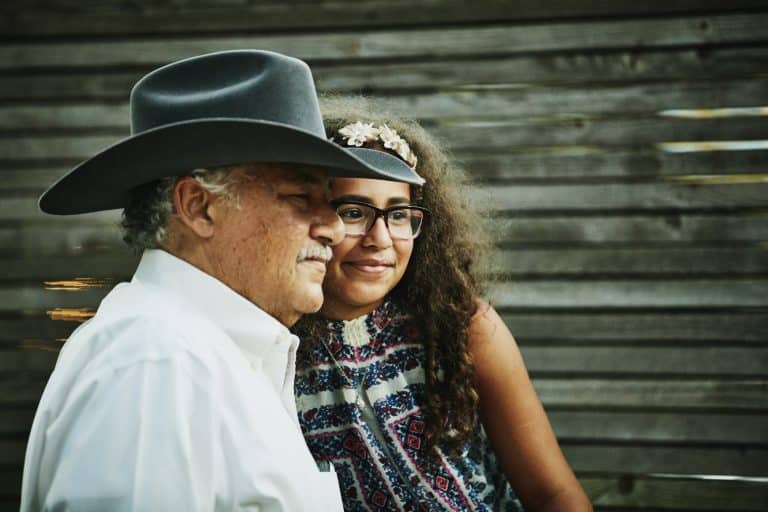
Image by Thomas Barwick/Getty Images, © All Rights Reserved.
We Survive by Telling Stories
“Write what should not be forgotten.” ~Isabel Allende
The first time my grandfather shared with me the story of La Llorona, I was a four-year-old girl with pigtails, tucked under his large right arm. He wore a white T-shirt and perfectly pressed blue jeans. The seam on his jeans created a riptide toward my small feet. His legs were raised on the recliner, and he held a cup of black coffee in his left hand. The aroma clung to my nostrils demanding to be known.
“Your tío came home scared the other day. While he was out fishing, he said a woman was floating on the water near his boat. Her cries were like the howl of a coyote and a raspy hollering like she was in deep misery or pain. He says she was wearing a wedding dress with a veil over her face.”
My grandfather took a slow sip of his hot coffee. My eyes widened and I held my breath until he spoke again.
“Pobrecita. She wouldn’t let him get out and kept crying for her children like he knew where they were. He was terrified.”
He trailed off and stared past me, out of the living room window. I dared not take my eyes off of him lest I miss something in his expressions.
“After all these years she’s still wandering. God doesn’t let her into heaven because she has to find her children. They drowned. Some say she did it, but I don’t believe that.”
My grandfather is ever the optimist. He takes another sip of coffee, slurping it slowly as if thinking over the story himself. La Llorona has us both wondering.
I grew up with folklore, hearing stories like La Llorona, the mother who howls near a local creek in desperation to find her drowned children. Her lament is in deep hope that her children or God will hear her and they will return. Her story frightened me, but it has never left me. It taught me most of what I know of faith.
I came to know of God in the faithful way stories are carried intergenerationally and in the way La Llorona remains devoted to finding her children.
Storytelling is a form of prayer. The posture and attention we give to storytellers as they elicit feelings and induce our bodies to draw near is the same engagement we see when we position ourselves to pray.
In the nook of my grandfather’s arm, I learned of Moses and how he freed the Israelites. I wept as my grandfather recounted working in the cotton fields under the laborious sun that nearly turned his body into a leather purse.
I learned of Pedro Infante and Lola Beltran singing together on a black and white television screen, a duo lending permission to hope in times of desperation. Rolling my grandfather’s thinning hair into pink rollers, while he recounted to me his dreams of flying an airplane and regrets of how the war missed him, I learned that even with only a fifth-grade education my grandfather was the most intelligent man I would ever know. The power of story is that it activates an intelligence that can never be learned in a classroom.
Storytelling originated as an oral tradition. The act is a prayer — even if the folktales, like the one of La Llorona, sound savage or bone-chilling. They get carried in the mouths of our elders and are passed across generations, trusted to the mouths of young folks. In so doing, our faith is strengthened through knowledge and obligation.
Generational storytelling is survival. It is a preservation of history and a dire act as we witness erasure in textbooks and watch our history recounted by those who tell our stories but have never lived in our skin or embodied the blood of our stories.
Many families have unfolded stories since a time that predates us all. There is a unique trust, much like faith, which happens during the transaction of storytelling. Once we receive the story, it becomes uniquely our own. When we share our stories, we bring all we carried when we showed up to receive them. Generational storytelling is a history book. It’s a catalogue of all the places we have been. It is a book entrusted to its people to ensure they are not forgotten.
I find we remain timeless around the dinner table. Sharing meals is a communal act. We pass around homemade flour and maiz tortillas. I laugh myself into fits of tears and learn stories like the significance of tattoos on relatives’ faces, unnoticed by younger generations who believed they were simply facial moles. Around the dinner table, we recount tales of jumping off of abuela’s roof onto the blue sea of our trampoline. We would later realize it was our faith that sprung before us and would always cushion our fall.
In high school, gathered at the table, eating cantaloupe pitted and filled with vanilla ice cream and pecans, abuela told us about her third-grade education. The family business required skills more than what she had to learn at school. Her mathematics worked best at a frutería erupting with fresh fruits where local folks made daily trips to find the best-farmed fruits and vegetables. In the same breath where she recounted tales of labor, she told me of the Levi’s factory work which stained her fingers blue. She spoke of women fighting for equal pay, reminiscent of Emma Tenayuca who, a few years before, had led a pecan sheller strike for fair wages. I learned about migrant farm workers and the proper way to give thanks to God before I left the table after a meal.
Thanksgiving and sacrifice through strength and lament were at the forefront of our lives much like the crying woman at the creek.
These stories were part of our evolving faith and relationship with the Most High. In them, I found that God labors with us, for us, and never against us. We tell stories at evening meals, lunch reunions, and when a family is gathered to share more than meals and gossip. This is what it is to be a church. Preserving our stories preserves our faith. It’s in this that the history of a body of people resists being erased. Will our family be remembered before colonization or will we forget the parting of the Red Sea so many years ago?
We are lost at the ends of sentences when our histories are not honored. It is an honor to carry a story on our backs and we hope that our children will grab hold of those backpacks, fill them with new stories and continue to carry the old ones.
This is how people survive. Story sits inside of the hollow conduit that is our throats awaiting its nacimiento, its birth. Each time a story is born, it rapidly morphs with generational trauma, present injustices, and situational highlights. These pragmatic realties attach themselves like moths and when a story finally cocoons, they present themselves in the self-awareness of the listener.
God has never brought La Llorona her children. She still wanders in grief for their return. It is a kind of purgatory. I used to wonder why she kept coming back. Her story would not leave me. As a mother, it always met me like the crossroads in our lives where faith demands to be known. Is my faith as strong as hers? Is it her faith that consistently brings her back because she still believes that her children will return to her, or like prayer, that God will hear her? She reminds me of Mother Mary who bore a son knowing he would be sacrificed on the altar of the world and still she remained faithful. Mary bore a son trapped between two worlds. These worlds are where we’re caught as human beings navigating our life and our faith. The first faith we come to know is holding a story well.
We pass on these narratives so that we are not forever wandering an in-between space. We tuck our children and grandchildren in the folds of our arms to inspire life. We task our family and friends with the call to deep wonder and imagination because if we continue to keep stories like La Llorona alive, we can continue to brave life with incredible faith.

Share your reflection